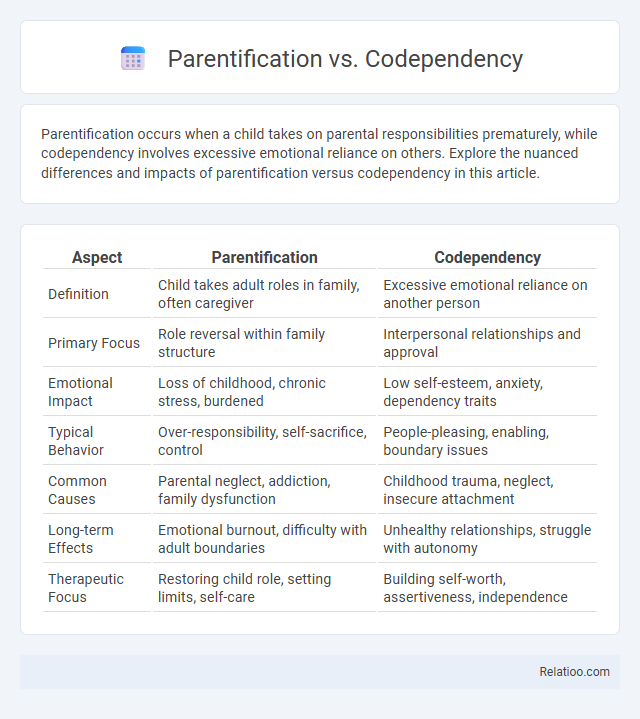Parentification occurs when a child takes on parental responsibilities prematurely, while codependency involves excessive emotional reliance on others. Explore the nuanced differences and impacts of parentification versus codependency in this article.
Table of Comparison
| Aspect | Parentification | Codependency |
|---|---|---|
| Definition | Child takes adult roles in family, often caregiver | Excessive emotional reliance on another person |
| Primary Focus | Role reversal within family structure | Interpersonal relationships and approval |
| Emotional Impact | Loss of childhood, chronic stress, burdened | Low self-esteem, anxiety, dependency traits |
| Typical Behavior | Over-responsibility, self-sacrifice, control | People-pleasing, enabling, boundary issues |
| Common Causes | Parental neglect, addiction, family dysfunction | Childhood trauma, neglect, insecure attachment |
| Long-term Effects | Emotional burnout, difficulty with adult boundaries | Unhealthy relationships, struggle with autonomy |
| Therapeutic Focus | Restoring child role, setting limits, self-care | Building self-worth, assertiveness, independence |
Understanding Parentification: Definition and Types
Parentification involves children assuming adult roles and responsibilities within the family, often leading to emotional and practical caregiving beyond their developmental stage. Types of parentification include emotional, where the child meets the emotional needs of the parent, and instrumental, which involves managing household tasks or finances. Understanding these distinctions is crucial for differentiating parentification from codependency, which centers more on mutual reliance and enmeshment in unhealthy relationships rather than imposed caregiving roles.
Codependency Explained: Core Characteristics
Codependency is characterized by excessive emotional or psychological reliance on a partner, often stemming from a dysfunctional family dynamic involving parentification, where a child assumes parental roles prematurely. Core traits include a strong need for approval, difficulty setting boundaries, and a tendency to prioritize others' needs over their own well-being. This condition often results in impaired self-identity and a persistent pattern of enabling unhealthy behaviors in relationships.
Key Differences Between Parentification and Codependency
Parentification occurs when a child takes on adult responsibilities, often caring for siblings or parents emotionally or physically, which disrupts their developmental needs. Codependency involves an excessive emotional or psychological reliance on a partner or family member, leading to neglect of one's own needs in favor of others. Understanding these key differences can help you identify if your role within a family is parentification, codependency, or a complex blend of both, enabling healthier boundaries and self-care.
Root Causes: Origins of Parentification and Codependency
Parentification originates from dysfunctional family dynamics where children assume adult roles due to parental neglect, emotional unavailability, or trauma, leading to premature responsibility. Codependency stems from patterns of unhealthy relational dynamics, often rooted in a family environment where boundaries are blurred, and one person's self-worth depends on caretaking others. Both conditions share origins in disrupted early attachments but differ as parentification emphasizes role reversal, while codependency highlights reliance on external validation within relationships.
Psychological Effects of Parentification on Children
Parentification forces children to assume adult roles prematurely, causing emotional burdens that can lead to anxiety, depression, and impaired identity development. Unlike codependency, which involves unhealthy reliance on others in relationships, parentification specifically distorts the parent-child dynamic, often resulting in feelings of guilt and chronic stress. These psychological effects increase the risk of long-term difficulties in forming healthy boundaries and maintaining balanced interpersonal relationships in adulthood.
The Impact of Codependency on Adult Relationships
Codependency in adult relationships often stems from childhood parentification, where a child assumes adult responsibilities prematurely, leading to blurred boundaries and an excessive need for approval. This dynamic fosters imbalanced relationships characterized by caretaking behaviors, emotional suppression, and difficulty establishing personal autonomy. Understanding these patterns is crucial for developing healthier communication and mutual support in adult partnerships.
Warning Signs: Identifying Parentification and Codependency
Warning signs of parentification include a child taking on excessive caregiving roles for parents or siblings, often sacrificing their own needs and emotional development. In contrast, codependency is characterized by a reliance on managing others' feelings and a loss of personal boundaries, leading to unhealthy relationship dynamics. Recognizing your own patterns of excessive responsibility or emotional enmeshment can help you address these issues and seek appropriate support.
How Parentification Leads to Codependent Behaviors
Parentification occurs when a child takes on adult responsibilities, often leading to blurred boundaries and unmet emotional needs, which are key factors contributing to codependency. You may find that this early role reversal fosters an excessive reliance on others for approval and self-worth, characteristic of codependent behaviors. Understanding the link between parentification and codependency is crucial for developing healthier relational patterns and emotional independence.
Healing and Recovery: Strategies for Breaking the Cycle
Healing from parentification and codependency involves recognizing unhealthy family dynamics and setting clear emotional boundaries to restore your autonomy. Engaging in therapy, such as cognitive-behavioral therapy (CBT) or trauma-informed counseling, supports recovery by addressing deep-seated patterns and fostering self-compassion. Developing healthy communication skills and building a supportive network empowers you to break the cycle and create balanced, nurturing relationships.
Seeking Support: Therapeutic Approaches and Resources
Therapeutic approaches for parentification focus on helping individuals set boundaries and reclaim their own developmental needs through modalities like cognitive-behavioral therapy (CBT) and trauma-informed therapy. In cases of codependency, therapy often emphasizes building self-esteem, fostering healthy relationships, and developing emotional autonomy using strategies such as dialectical behavior therapy (DBT) and family systems therapy. Seeking support from specialized therapists and support groups can empower you to navigate these dynamics, promoting healing and healthier interpersonal patterns.

Infographic: Parentification vs Codependency
 relatioo.com
relatioo.com